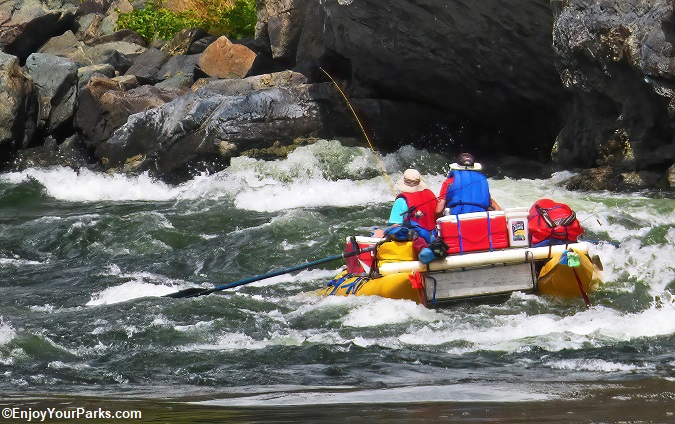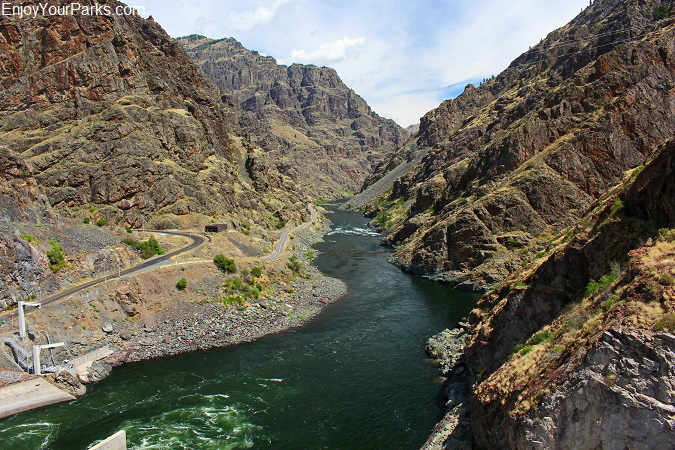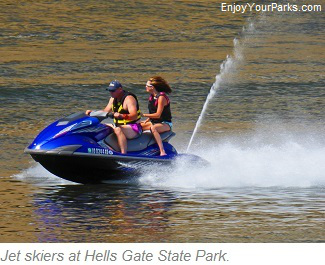Hells Canyon National Recreation Area
Includes Hells Canyon Scenic Byway, Hells Gate State Park

Hells Canyon National Recreation Area in Idaho
 Hells Canyon National Recreation Area is North America's deepest river gorge. At 7,993 feet, this magnificent gorge is well over 2,000 feet deeper than the Grand Canyon, and as you enter this awe-inspiring canyon via river boat or raft, you will be absolutely stunned at the height of the walls towering
Hells Canyon National Recreation Area is North America's deepest river gorge. At 7,993 feet, this magnificent gorge is well over 2,000 feet deeper than the Grand Canyon, and as you enter this awe-inspiring canyon via river boat or raft, you will be absolutely stunned at the height of the walls towering
over the Snake River.
The Hells Canyon Recreation Area is a 652,488 acres in size, and straddles the mighty Snake River between Idaho on the east side and Oregon to the west.
Much of this incredible region is extremely remote, with little or no access by vehicles. The only access to most of the Hells Canyon National Recreation Area is by river boat or raft, which adventurers undertake with either their own equipment or rentals.
There are several camping areas located throughout Hells Canyon, as many visitors choose to make this a multi-day adventure.
Jet Boat Tours
An extremely popular way for visitors to see Hells Canyon is to take a Jet Boat Tour that takes them upstream from Lewiston Idaho all the way through the Hells Canyon National Recreation Area, and ending up at Hells Canyon Creek Visitor Center and Hells Canyon Dam. These amazing excursions are usually a full day adventure, and is a trip you'll never forget!

Jet boat tour guide company heading for the Hells Canyon Dam.
Guided Fishing Trips
In addition to Jet Boat Tours, another popular activity visitors partake in is fishing. There is some outstanding fishing opportunities in Hells Canyon, and there are several excellent fishing guide companies that can take you to where the fish are!

Fishing boat blasting through some rapids on the Snake River in Hells Canyon.
Overnight Rafting Adventures
 Yet another popular way to explore Hells Canyon Recreation Area is to take a river raft from Hells Canyon Creek Visitor Center all the way downstream through the heart of Hells Canyon.
Yet another popular way to explore Hells Canyon Recreation Area is to take a river raft from Hells Canyon Creek Visitor Center all the way downstream through the heart of Hells Canyon.
This trip is a multi-day river rafting adventure, and you can either "do it yourself" or go with a qualified guide.
About Hells Canyon
Hells Canyon encompasses a very large remote region in Idaho (east side) and Oregon (west side), and is home to incredible changes in terrain, climate, vegetation and elevation. The Hells Canyon National Recreation Area includes portions of three national forests, and is managed by the Wallowa-Whitman National Forest.

River rafters preparing for a multi-day adventure in Hells Canyon.
The legendary Snake River carved the Hells Canyon through the ages, where this magnificent canyon dives nearly 8,000 vertical feet below He Devil Peak of Idaho's Seven Devils Mountains. This location makes Hells Canyon the deepest gorge in North America, even rivaling the Grand Canyon, which is over two thousand feet less deep than Hells Canyon. Having a tremendous 10 mile expanse, Hells Canyon is only accessible by three roads between the Hells Canyon Dam and the Washington-Oregon boundary, and of course via river boats and rafts.

Hells Canyon National Recreation Area is one of the most scenic river adventures in North America!
National Wild and Scenic River
Approximately 68 miles of the Snake River in Hells Canyon National Recreation Area was designated part of America's "Wild and Scenic Rivers System" in 1975. This section of the Snake River is carefully managed to preserve its free-flowing nature and environment, all the while providing public use.
Geology of Hells Canyon
 The geological history of Hells Canyon began about 300 million years ago when a series of volcanoes emerged from the Pacific Ocean. Through the course of millions of years, the volcano activity ended, and limestone began to build up on the underwater platforms, and eventually the basins between the platforms were filled up with sedimentary rock.
The geological history of Hells Canyon began about 300 million years ago when a series of volcanoes emerged from the Pacific Ocean. Through the course of millions of years, the volcano activity ended, and limestone began to build up on the underwater platforms, and eventually the basins between the platforms were filled up with sedimentary rock.
Then between 125 and 16 million years ago the ocean plate carrying the volcanoes actually collided with North America, and thus became part of the continent of North America. Then a period of heavy volcanic activity occurred, covering a vast majority of the area with basalt lava, which created a very flat high plateau approximately 6 million years ago. The Snake River then began to cut through the basalt rock, and carved what we see today in Hells Canyon. Surprisingly, as recently as 15,000 years ago, there was significant carving of Hells Canyon during a tremendous flood from an outburst of Glacier Lake Bonneville in Utah.
Seven Devils Mountain Range
Hells Canyon National Recreation Area is among some of the wildest and remote areas in the nation, where its visitors will be exposed to everything from barren, dry, steep slopes to high country alpine country of the Seven Devils Mountain Range.
These towering mountains were named for a vision of seven dancing devils that appeared to a Native American who was lost in this rugged area. These amazing mountain peaks rise to elevations over 9,000 feet above sea level, and are named "He Devil", "The Twin Imps", and "She Devil".
The Wildlife
 Hells Canyon National Recreation Area is home to many varieties of animal species such as mule deer, black bears, Rocky Mountain bighorn sheep, elk, bald eagles, hawks, golden eagles, osprey, coyotes, bull trout and much much more.
Hells Canyon National Recreation Area is home to many varieties of animal species such as mule deer, black bears, Rocky Mountain bighorn sheep, elk, bald eagles, hawks, golden eagles, osprey, coyotes, bull trout and much much more.
We highly recommend that you bring your binoculars for your Hells Canyon visit, whether you are taking a guided jet boat tour or driving along the Hells Canyon Scenic Byway. We happened to see this black bear cub and its mother near the Hells Canyon Creek Visitor Center along the Hells Canyon Scenic Byway. They were just off the highway and added greatly to our wonderful day in this fantastic area.
Trailheads For Hikers
There is an extensive hiking trail system along the Idaho side of Hells Canyon that mainly follows old Forest Service access routes. Many of these Hells Canyon hiking trails follow high ridges and sometimes traverse across moderately steep slopes and benchlands. Some traverses are very steep and extreme caution needs to be used by its visitors. The major trailheads can be reached from Riggins Idaho, which are Black Lake Campground (Trail #214), Windy Saddle Trailhead/Windy Saddle Horse Camp (Trail #124), Heavens Gate Trailhead (Trail #101) and Snake River Trailhead (Trail #102).
South Access: Hells Canyon Scenic Byway

Hells canyon Scenic Byway follows the Hells Canyon Reservoir all the way to the Hells Canyon Dam and then onto Hells Canyon Creek Visitor Center, which is the end of road!
 Beginning at Oxbow Bridge near Homestead Idaho on Idaho State Highway 71, the Hells Canyon Scenic Byway is an extremely remote, paved byway that takes visitors through an amazing 22 mile scenic adventure as it works it's way downstream along Hells Canyon Reservoir of the Snake River.
Beginning at Oxbow Bridge near Homestead Idaho on Idaho State Highway 71, the Hells Canyon Scenic Byway is an extremely remote, paved byway that takes visitors through an amazing 22 mile scenic adventure as it works it's way downstream along Hells Canyon Reservoir of the Snake River.
The Hells Canyon Scenic Byway abruptly ends at the Hells Canyon Creek Visitor Center which is located just over a mile beyond Hells Canyon Dam and marks literally a "dead end", where any further access to Hells Canyon is by boat or raft.
The scenery the entire way is breathtaking, as the road winds along the east side of Hells Canyon Reservoir, which is the Idaho side of the canyon. Towering cliffs of green, brown and black basalt loom on each side of the canyon as this narrow and winding road takes you deeper and deeper into the canyon. There are several very nice campgrounds and boat launches found along the Hells Canyon Scenic Byway for visitors interested in spending more time along the Hells Canyon Reservoir.

The view of Hells Canyon Reservoir from the Hells Canyon Scenic Byway is spectacular!
RV Campgrounds & Picnic Areas
Along the Hells Canyon Scenic Byway, you will pass along several Hells Canyon Snake River Reservoirs, and along these reservoirs you will find four outstanding day use areas and overnight RV campgrounds. Wood Head Park, McCormick Park, Copperfield Park and Hells Canyon Park all provide well maintained tent and full service RV camping, as well as wonderful day use areas that are well suited for picnics. Each of these parks also provide boat landings.
Hells Canyon Dam
 Near the end of the Hells Canyon Scenic Byway lies the magnificent Hells Canyon Dam. This concrete gravity dam is located on the Snake River at river mile 247, and is the third and final dam in the Hells Canyon Project of the Idaho Power Company. The other two dams are the Oxbow Dam and Brownlee Dam.
Near the end of the Hells Canyon Scenic Byway lies the magnificent Hells Canyon Dam. This concrete gravity dam is located on the Snake River at river mile 247, and is the third and final dam in the Hells Canyon Project of the Idaho Power Company. The other two dams are the Oxbow Dam and Brownlee Dam.
The Hells Canyon Complex on the Snake River is regarded as the nation's largest privately owned hydroelectric power complex.
The Hells Canyon Scenic Byway crosses the top of the dam as it heads from the east side to the west side of Hells Canyon. If you're going to take a photo from the top of the Hells Canyon Dam, make it quick because stopping on the dam is prohibited. Just about a mile further the Hells Canyon Creek Visitor Center marks the end of the road and the beginning of the extremely remote and wild section of Hells Canyon.

A view from the top of Hells Canyon Dam, looking into the remote Hells Canyon National Recreation Area.
Hells Canyon Creek Visitor Center
 The Hells Canyon Creek Visitor Center is located about one mile downstream from Hells Canyon Dam, and it marks the end of not only the Hells Canyon Scenic Byway, but also the end of the road...period. Only boats and rafts can continue on further into Hells Canyon.
The Hells Canyon Creek Visitor Center is located about one mile downstream from Hells Canyon Dam, and it marks the end of not only the Hells Canyon Scenic Byway, but also the end of the road...period. Only boats and rafts can continue on further into Hells Canyon.
The Hells Canyon Creek Visitor Center provides very nice indoor interpretive exhibits and programs, and is open from Spring through late Summer.
The outdoor displays are available to visitors all year round. There are also picnic tables, toilets, parking area and the Hells Canyon Boat Launch, which is one of the main boat launches in the entire Hells Canyon National Recreation Area.
From the Hells Canyon Creek Visitor Center, you will be able to watch jet boats entering and leaving Hells Canyon, as well as watching river rafters leaving the boat launch as they embark on their wilderness journey down this incredibly remote and wild section of Hells Canyon.

Visitors heading up to the Hells Canyon Creek Visitor Center from their jet boat. These folks started out at Lewiston Idaho, nearly 100 river miles from this spot!




North Access: Hells Gate State Park in Lewiston Idaho
 The most popular northern access (boat only) into Hells Canyon begins at Lewiston Idaho. Hells Gate State Park in Lewiston Idaho marks the beginning for most jet boat tours of Hells Canyon, where visitors can access Hells Canyon National Recreation Area by heading up stream on the Snake River all the way to Hells Canyon Dam, which is nearly a 100 river miles from Lewiston.
The most popular northern access (boat only) into Hells Canyon begins at Lewiston Idaho. Hells Gate State Park in Lewiston Idaho marks the beginning for most jet boat tours of Hells Canyon, where visitors can access Hells Canyon National Recreation Area by heading up stream on the Snake River all the way to Hells Canyon Dam, which is nearly a 100 river miles from Lewiston.
These popular river tours utilize powerful jet boats that fight their way upstream to reach Hells Canyon, Hells Canyon Creek Visitor Center and Hells Canyon Dam, which is a 200 mile round trip river excursion. There are several tour companies based out of Lewiston Idaho and the surrounding area, and most provide either half day or full day river adventures.
Hells Gate State Park
Located in Lewiston Idaho, Hells Gate State Park is a 960 acre park that is open year round and is not only a popular camping and Snake River boating/swimming destination, but is also a major access point for visitors taking jet boat tours of Hells Canyon that is located nearly 80+ miles to the south on the Snake River.

Hells Gate State Park is a popular destination for boaters on the Snake River in Lewiston Idaho.


Campground
The campground provides 51 full service and 29 standard campsites, and eight cabins. Flush toilets, showers, dump station and electricity is available at the Hells Gate State Park Campground as well.
Marina/Boat Launch
Hells Gate State Park is also home to a major marina and boat launch, where private boats and professionally guided jet boats begin their upstream journeys into Hells Canyon National Recreation Area which is over 80 miles to the south of Lewiston Idaho.

Hells Gate State Park is a great place to swim, boat and jet ski.
Activities
Hells Gate State Park is home to many activities that include picnicking, camping, mountain biking, cycling, fishing, boating, swimming, horseback riding, wildlife viewing and of course jet boat tours into Hells Canyon National Recreation Area.
Lewis and Clark Discovery Center
 Hells Gate State Park provides an outstanding interpretive center that highlights the remarkable journey of Lewis and Clark in the early 1800s.
Hells Gate State Park provides an outstanding interpretive center that highlights the remarkable journey of Lewis and Clark in the early 1800s.
The Lewis and Clark Discovery Center is extremely well done, and does an outstanding job telling the story of the Lewis and Clark Expedition, and is very much worth your time to discover and explore if you're interested in fascinating Western history.
There are fantastic displays and movies about the Corp of Discovery (Lewis and Clark Expedition and Nez Perce Tribe.


Additional Access Point To Hells Canyon National Recreation Area: Pittsburgh Landing (Deer Creek Road)
In addition to the Hells Canyon Scenic Byway access from the south, and the river boat access from Lewiston Idaho to the north, the Pittsburgh Landing can be reached by taking Deer Creek Road from the town of White Bird (Idaho on U.S. 95) for seventeen miles on a narrow gravel road. Pittsburgh Landing is home to a campground and boat launch.




